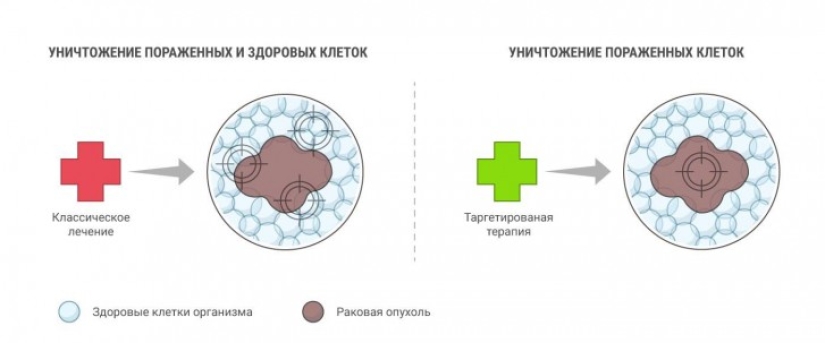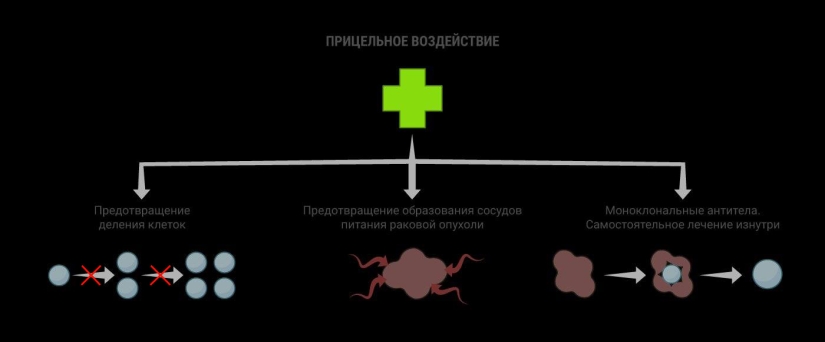Molecules that were not, or How to cure cancer with the help of mathematics
Categories: Health and Medicine
PictolicDespite the fact that surgery and chemotherapy are still the most common types of cancer treatment today, the hopes of the world scientific community in the fight against the main disease of the 21st century are directed in a completely different direction - towards the so-called targeted therapy.
In what, actually, business. Classical methods, such as surgery, radiation or chemotherapy, in an effort to kill cancer cells, "sweep away" all living things in their path, provoking horrific side effects in the rest of the body. Targeted therapy - in fact, the name hints at the essence - affects only the specific mechanisms that occur in the affected cells, practically without affecting their healthy neighbors.
This “targeted” effect is achieved by scientists in the pharmaceutical industry in different ways. Some are developing drugs that suppress the work of proteins that trigger the process of abnormal cell division. Others are looking for a substance that can block the formation of new vessels that provide nutrition and tumor growth. Still others hit quite fundamentally: they create unique biomolecules - the so-called "monoclonal antibodies" - that allow the body to cure the disease on its own (similar to how our immune system reacts, for example, to some kind of SARS).
(Total 2 photos)

The latter strategy seems to be the most promising for the world scientific community, as it gives positive predictions of complete recovery from cancer, even at advanced stages. And it is precisely this direction that the Russian company BIOCAD is engaged in (we wrote about it earlier), which has been successfully developing unique drugs based on monoclonal antibodies for the treatment of oncological, autoimmune and other diseases for more than 15 years.
What are these magical antibodies? Everything here is very non-trivial.
There are a number of animals on our planet that do not get cancer. For example, llamas. They naturally have antitumor monoclonal antibodies that protect them. The human body does not produce such antibodies. Accordingly, in order to treat people for cancer, it is necessary to artificially “implant” these same monoclonal antibodies into them.
But there are difficulties here. Animal-derived antibodies cannot simply be used to treat humans - the negative consequences of not accepting proteins by the human immune system may exceed the therapeutic effect. That is, it is necessary to solve the problem of humanization - the transformation of animal antibodies into human ones in such a way as to remove their negative properties, while retaining useful ones. To do this, you need to understand what antibodies generally exist both in humans and in animals. Despite the identity of the original antibody genes in all people, the process of their mutation occurs individually. As a result, millions of fragments of the protein chain, having a unique structure, form “when mixed” an innumerable number of combinations, each of which can turn out to be the same universal healing molecule.

Here it should be noted without exaggeration that in solving this most difficult task of analyzing the diversity of antibodies in humans and animals, Russian scientists from BIOCAD are “three blocks ahead” of the whole world. Since 2012, the company's laboratories have been creating a library of human antibodies, which is currently the largest in the world. The library is a repository of billions of genes for various antibodies, each of which is individual and is actually present in human blood. The same libraries are created from llama monoclonal antibodies.
With this unique data collected from more than 2,000 donors, scientists are identifying the most versatile combinations of human protein chain fragments and comparing them with animal antibodies to obtain the desired healing formula.
Carrying out this kind of analysis requires not only biological knowledge, but also the use of mathematical apparatus. Thanks to the achievements of bioinformatics and high-precision equipment in the company's laboratories, scientists perform a multi-stage analysis of possible compounds, identifying combinations that will give the best results in terms of the totality of the "humanity" of the antibody and its specific properties. For such "successful candidates" on three-dimensional structural models, experts predict exactly how the resulting "hybrids" will manifest their activity, and can also find ways to increase their effectiveness. And already, based on the results of mathematical selection and computer modeling, several of the most promising options are identified from the entire variety of molecules, which are already being synthesized in the laboratory. The next step towards which BIOCAD is purposefully moving today is the transition from humanized molecules to directly human ones, that is, the complete rejection of animal antibodies. It is thanks to the constant expansion of the library of human antibodies and the methods of mathematical modeling and improvement of molecules developed by the company that this will become possible in the very near future.
Previously, the company learned how to obtain effective antibody molecules in an amount sufficient to treat thousands of patients both in the Russian Federation and in other countries. Having a base that allows you to quickly bring molecules with high potential to patients is the basis of successful projects for the development of innovative drugs. Thus, scientists managed to work out the process in a short time, set up production, successfully conduct clinical trials and launch on the market the first biosimilar of the synthetic drug Rituximab (used to treat lymphoma), and in the near future a new drug is expected to be released - an analogue of Bevacizumab (treatment bowel cancer).
Through the efforts of scientists today, more than 10 drugs with molecularly targeted action are being developed in clinical conditions. Several are being tested. Their appearance on the pharmaceutical market is expected in the coming years. And with them - and the opportunity to talk about the complete victory over the main disease of the XXI century.
Recent articles

In life, every person has a case when he is on the verge of death. Sometimes fate gives you one chance, rarely more. Canadian ...

Folk remedies used to treat ailments in Russia were numerous and varied. The carriers of knowledge about the means and methods of ...
Related articles

Despite the fact that sexually transmitted diseases have been known for more than one century, they were effectively treated ...

Self-medication for people in the post-Soviet space is the most common thing. Most of us believe that before going to the doctor, ...

Everyone knows that nature and communication with animals have a positive effect on a person and allow you to relax and cope with ...

Unfortunately, during the war, it was rarely possible to hand over the bodies of the dead to their relatives. During particularly ...